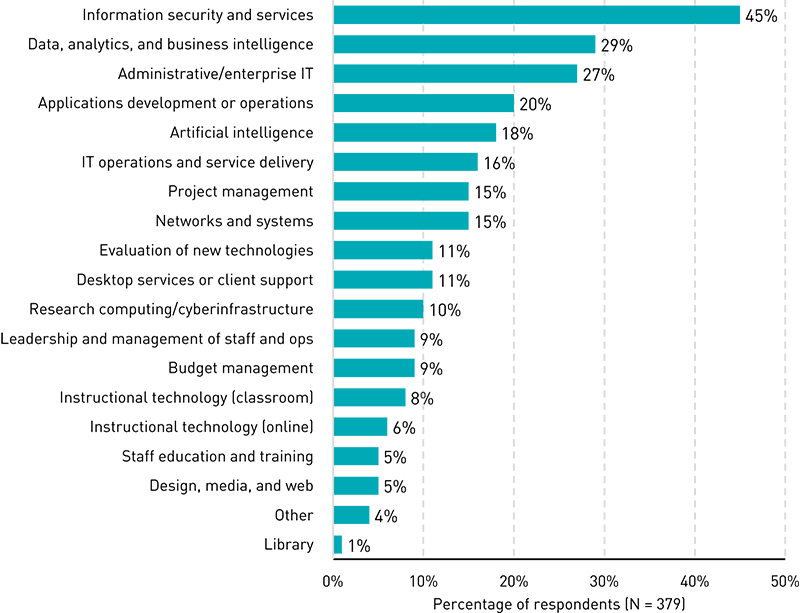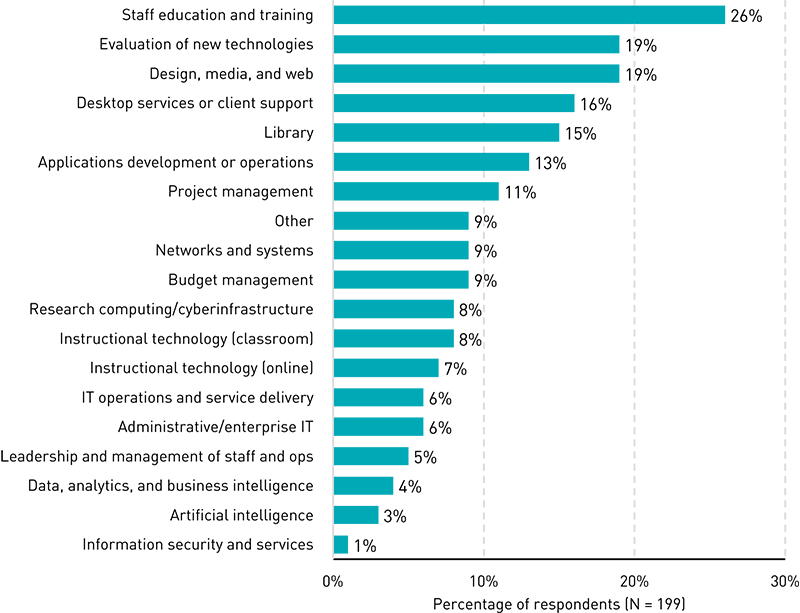Current Role and Organization
This report focuses on IT and technology leaders in higher education: those persons working in roles from director-level positions up to CIO-level and vice president–level positions (see figure 1). Our survey respondents were more heavily weighted toward director-level positions—positions that may come with very different responsibilities and experiences from those of senior-level CIO and VP positions—so throughout the report we note areas where director-level respondents differed significantly from higher-level respondents. Overall, though, we find that leaders across these different levels share many professional experiences, needs, and challenges.
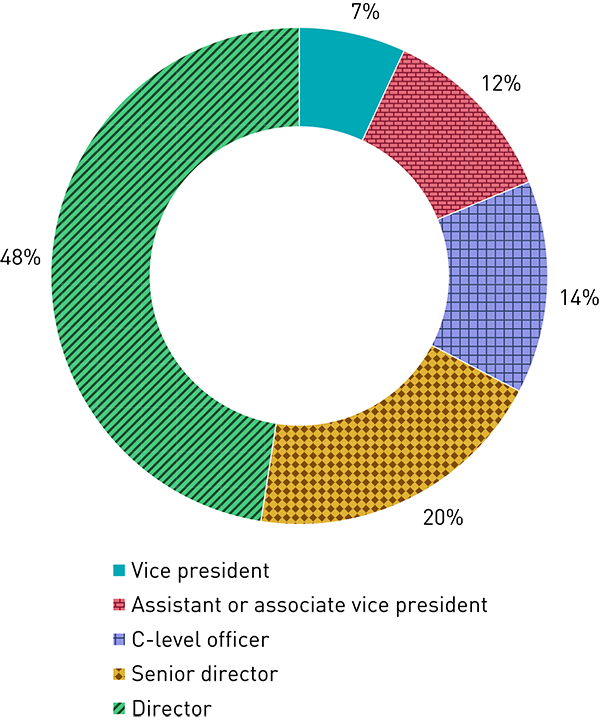
Respondents are relatively new to their current positions: more than half (55%) reported being in their current position for four years or less (see figure 2). The COVID era certainly accelerated shifts in the professional job market, including the technology and higher education job markets, providing many institutions with influxes of newly minted leaders from both within and outside the higher education industry. And we may not have seen the last of these job market shifts, as the longer-tenured respondents to our survey are also less satisfied with their "mobility and growth opportunities" and more likely to report that they intend to apply for other positions in the coming year.
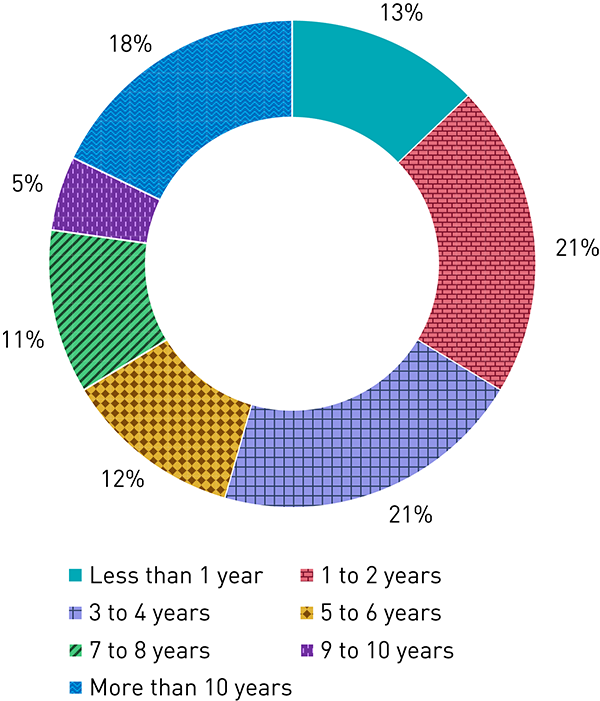
Senior-level leaders are much more likely to report to the president or vice president at their institution, and director-level leaders are more likely to report to C-level or vice president–level supervisors (see figure 3). Regardless of position, a full 82% of respondents reported that their current reporting line is, in fact, the correct one. Previous EDUCAUSE research has demonstrated the correlation between reporting lines and leadership efficacy. In this study, relatedly, we found that agreement with one's current reporting line correlates positively and significantly with every measure of job satisfaction we asked about in our survey.
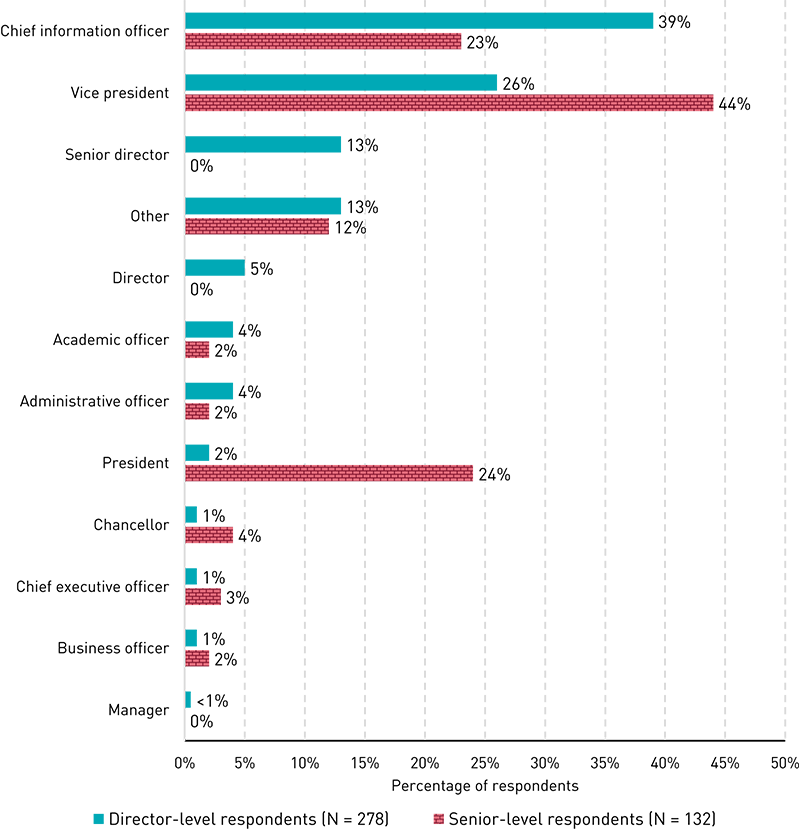
The demographic composition of our survey respondents remains roughly as homogeneous as it has been in workforce studies past. The mean age of our respondents was 53, and 55 among the more senior-level respondents. Just under a third of respondents (31%) self-identified as a woman, a figure that drops to 25% among more senior-level respondents. Small percentages of respondents self-identified their racial/ethnic background as Hispanic (4%), Asian (6%), or Black or African American (3%). Few respondents self-identified as being a member of the LGBTQIA+ community (5%) or as having a disability (8%).
Asked to select from a list their primary areas of responsibility in their position, only three areas of responsibility were selected by a majority of respondents: leadership and management of staff and operations (62%), IT operations and service delivery (55%), and administrative/enterprise IT (53%) (see figure 4). Of course, most leaders do not hold just a singular area of responsibility. A full 83% of respondents selected more than one area of responsibility as their primary, and senior-level leaders on average reported having nine total areas of responsibility, compared to an average of five among director-level leaders.
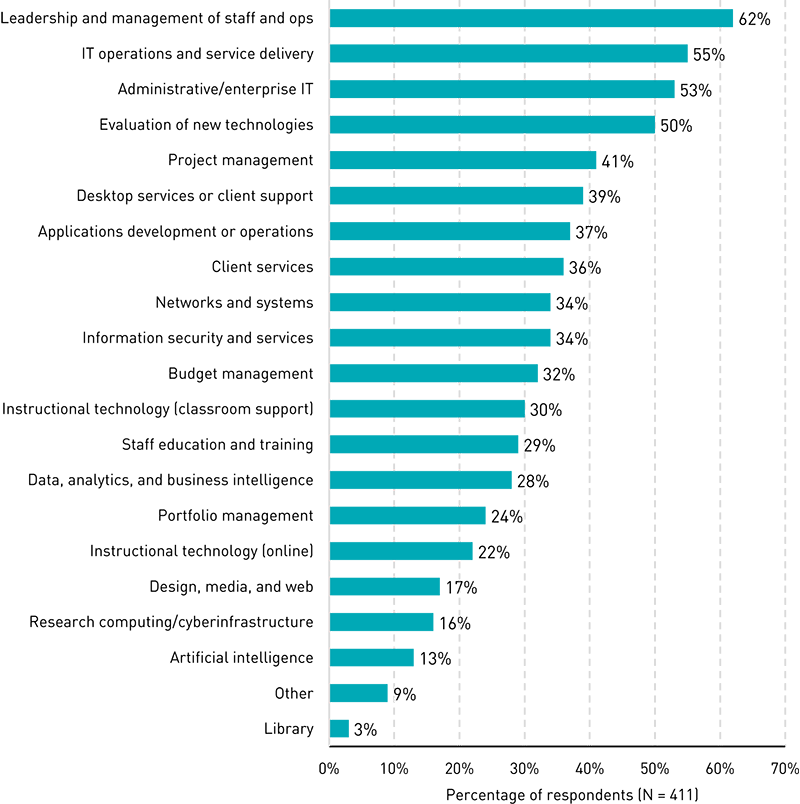
Respondents were asked to estimate the number of full-time equivalent (FTE) staff budgeted for each of their primary departments or units of responsibility (see table 1). Administrative/enterprise IT (6), library (6), and desktop services or client support (5) were the areas with the highest average number of FTE staff, while artificial intelligence and evaluation of new technologies were the areas with the lowest average number of FTE staff, each with a median FTE staff of 0.
| Department/Unit | Mean | Median | N |
|---|---|---|---|
| Administrative/enterprise IT | 26 | 6 | 195 |
| Library | 16 | 6 | 11 |
| Applications development or operations | 11 | 4 | 142 |
| Other | 11 | 4 | 36 |
| Client services | 9 | 4 | 119 |
| IT operations and service delivery | 9 | 3 | 183 |
| Desktop services or client support | 7 | 5 | 143 |
| Networks and systems | 6 | 3 | 128 |
| Leadership and management of staff and operations | 5 | 3 | 224 |
| Instructional technology (classroom) | 4 | 2 | 112 |
| Research computing/cyberinfrastructure | 4 | 1 | 61 |
| Data, analytics, and BI | 3 | 2 | 106 |
| Design, media, and web | 3 | 2 | 63 |
| Instructional technology (online) | 3 | 2 | 81 |
| Artificial intelligence | 3 | 0 | 48 |
| Budget management | 2 | 1 | 119 |
| Information security and services | 2 | 1 | 122 |
| Project management | 2 | 1 | 151 |
| Portfolio management | 1 | 1 | 87 |
| Staff education and training | 1 | 1 | 102 |
Regardless of the size of the department/unit, some are likely enjoying the luxuries of newly created positions and the added capacities they afford, while others are eliminating positions and presumably seeing their capacities diminished or at least changed (see table 2). Interestingly, for every department/unit, more institutions have added new positions than have eliminated existing ones. And for some—applications development or operations; information security and services; design, media, and web; networks and systems; and staff education and training—more institutions are outsourcing positions than are creating or eliminating positions. The landscape of higher education and the world around it is evolving, and institutions' organizational structures and workforce are evolving along with it.
| Department/Unit | Created Positions | Eliminated Positions | Outsourced Positions |
|---|---|---|---|
| Library | 33% | 8% | N/A* |
| Research computing/cyberinfrastructure | 26% | 3% | 5% |
| Other | 23% | 3% | 21% |
| Administrative/enterprise IT | 23% | 16% | 18% |
| Applications development or operations | 22% | 10% | 25% |
| Information security and services | 20% | 2% | 27% |
| Desktop services or client support | 18% | 9% | 7% |
| Data, analytics, and BI | 16% | 5% | 13% |
| IT operations and service delivery | 16% | 7% | 12% |
| Project management | 16% | 8% | 9% |
| Client services | 16% | 7% | 7% |
| Artificial intelligence | 14% | 4% | 6% |
| Leadership and management of staff and operations | 14% | 8% | 2% |
| Instructional technology (classroom) | 13% | 6% | 12% |
| Design, media, and web | 12% | 3% | 25% |
| Networks and systems | 11% | 6% | 18% |
| Instructional technology (online) | 9% | 5% | 7% |
| Portfolio management | 9% | 2% | 2% |
| Staff education and training | 8% | 4% | 10% |
| Budget management | 5% | 2% | 3% |
| Evaluation of new technologies | 4% | 2% | 2% |
| * All respondents left this question blank. | |||
It is here that we should pause to acknowledge that many of the above observed patterns in staffing and structure differ across types and sizes of institutions. In our survey, respondents from larger institutions reported larger numbers of staff across most of their departments or units, and they were significantly more likely to report creating new positions in some areas. Respondents from smaller institutions, on the other hand, were significantly more likely to report eliminating positions in certain areas and, on average, to report having eight primary areas of responsibility, compared with six among respondents from larger institutions.
Regardless of institution size, the focus of our respondents' work is ever shifting to adapt to the emerging needs and challenges of their institution. Nearly all respondents (94%) indicated that at least one of their departments or units had experienced a large increase in time demands over the past 12 months. Information security and services in particular has seen growth in demand, with 45% of respondents indicating increases in this area (see figure 5). These increases are not balanced by decreases in other areas—just over half of all respondents (57%) indicated that at least one of their departments or units had experienced a decrease in time demands (see figure 6).
